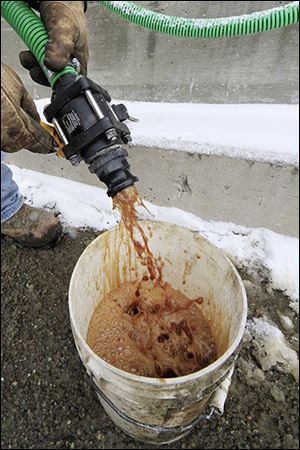
Food by-products useful ice-melting tools
Beet juice and brine are among the mix in combating slippery highway hazards
1/8/2014
Beet juice is used by some highway crews to melt ice on roads because rock salt is largely ineffective below 16 degrees.
When rock salt and brine no longer work to thaw ice-covered roads, the Ohio Department of Transportation selectively applies beet juice mixed with grit or fine gravel to improve drivers’ traction, a department spokesman said on Tuesday.
But “selectively,” spokesman Theresa Pollick said, is an important word in that statement.
Straight rock salt is only effective to about 16 degrees; colder than that, even salt water freezes.
Additives such as beet extract, a by-product of refining beets for sugar, can lower the melting point well below zero, but even that has its limits.
“We’re concerned because if we use any type of material, under these conditions, it’s going to freeze again,” Ms. Pollick said.
“We’re using beet derivative, but very carefully,” she said. “We have to be extremely selective.”
The ODOT spokesman said state crews had spread a grit-stone mixture with beet juice on I-75’s snow-packed pavement at several curves just south of the Michigan border, but some motorists were traveling fast enough that they still lost control.
There were no similar crashes on the northbound side, which Ms. Pollick said led state officials to conclude that the problem was with drivers approaching the Ohio line on relatively straight pavement only to encounter rapidly changing conditions once they crossed the border.
ODOT does not service the Ohio Turnpike, which provides its own plowing and salting.
This year and last year, the Ohio Turnpike Commission purchased rock salt and liquid magnesium chloride, a de-icing material, to use on the highway.
Ohio is one of several states, including Pennsylvania and New York, that have experimented with beet juice, molasses, or even brine from cheese-making to beef up their ice-fighting capability during extreme cold.
Many of the food derivatives are in commercially marketed products with names such as Ice Bite and Magic Salt. But in Milwaukee, transportation officials are mixing their own brew.
As part of a pilot program, the city’s fleet operations manager, Jeffrey Tews, has sent trucks to some of Wisconsin’s 140 cheese plants to pick up brine, which is used to wet the roads and rock salt.
City officials are looking at whether brine, free except for transportation costs, can replace the 70-cents-a-gallon liquid calcium chloride now used as a pretreater and melting enhancer.
In addition to wetting the salt to make it stay on the roads better, the brine lowers the temperature at which the salt works.
The brine’s got a bit of a cheesy smell up close, Mr. Tews says, but in the few times it’s been used, no one has complained.
“We’re taking a product that normally would have been disposed of and repurposing it,” he said. “It could be economical. It’s too soon to project.”
Leland Smithson, an ice and snow expert at the American Association of State Highway and Transportation Officials, said wastewater from hydraulic fracturing — technology used to drill for oil and natural gas using high volumes of fluid — is another substance being looked at, though it’s not thought to be in use anywhere.
David Welch, Toledo’s commissioner of streets, bridges, and harbor, said Toledo uses calcium chloride as a wetting agent for salt during cold weather, but even that has a hard time breaking up the hard-packed snow that develops on streets after a big storm and a deep freeze.
“Once it’s down there, it’s very hard to break,” Mr. Welch said.
Toledo does not use sand or grit as a traction booster, he said.
“On unimproved [curbless] streets, that’s not a bad idea, but because it plugs up storm sewers, we don’t use sand or gravel,” the streets commissioner said.
The city and ODOT often spray salt brine on major routes before winter storms to weaken the bond that forms between pavement and packed snow or ice.
Doing so, transportation experts say, reduces the total amount of salt ultimately used. Nonsalt additives also reduce salt’s corrosive action on metals and the damage it does to plants.
The Blade’s news services contributed to this story.
Contact David Patch at: dpatch@theblade.com or 419-724-6094.